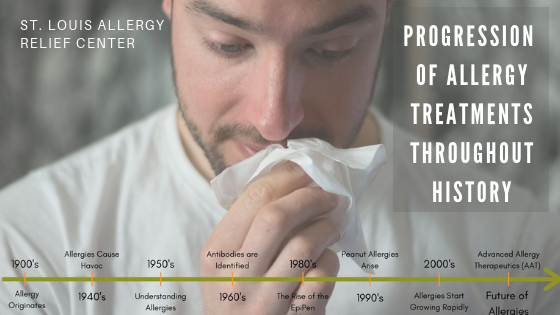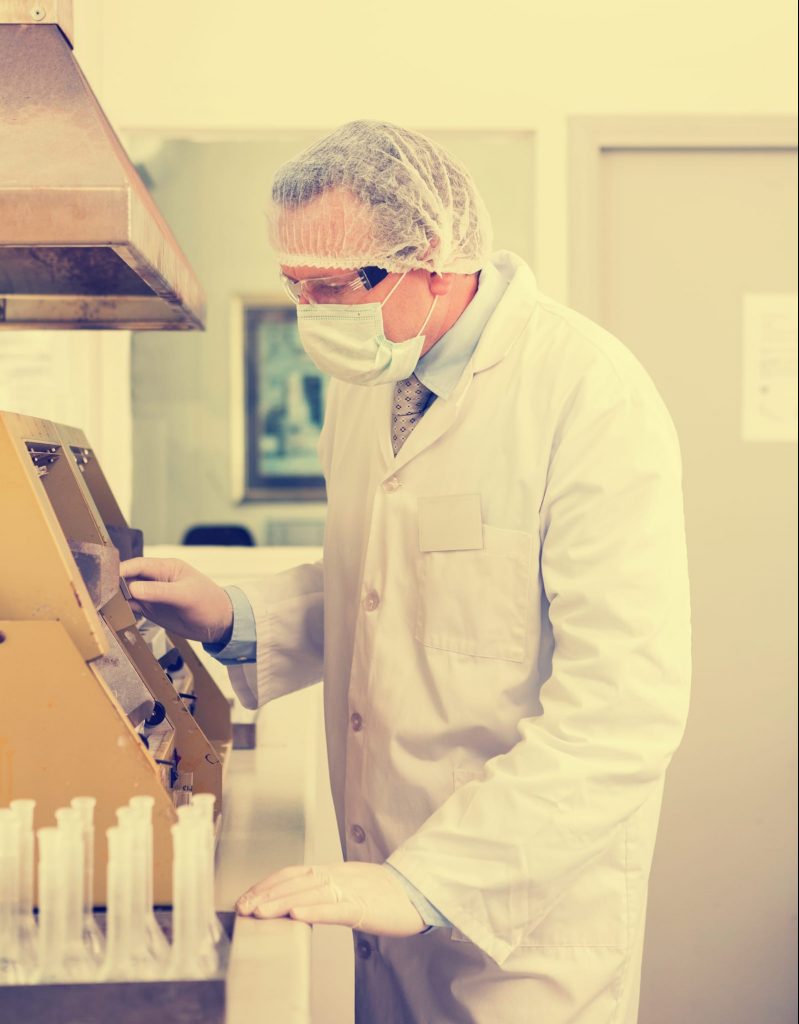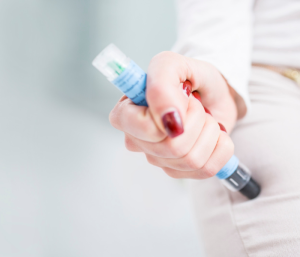Progression of Allergy Treatments Throughout History

How did people deal with allergies before they even knew what was happening to them? Allergies have been around for centuries, but the treatments to deal with them has not. We’ve created a timeline of the different advancements of allergy treatments throughout the years to show you just how difficult living with allergies may have been in the past compared to the 21st century.
Keep reading for a timeline of the history of allergy treatments
Where does it come from?
The term allergy wasn’t actually coined until the early 1900’s by a man named Clemens von Pirque who noticed patients of his having a reaction to a second dose of horse serum, a type of medication used to try and cure smallpox. Pirquet found that the symptoms were being caused by the immune system producing antibodies to fight foreign substances contained in the serum, or antigens. It was in 1906 when Pirquet created the term for the antibodies-antigens interaction, a term we are all very familiar with today: allergies.
After the interaction was discovered over the course of the next few years allergies seemed to be the cause of hay fever, asthma, some skin diseases, and anaphylaxis-which is an extreme allergic reaction that could easily cause death. Although the link to asthma and anaphylaxis had been made, it took many years before the connection was noticed between anaphylaxis and the body’s production of histamine. At that point, the interest in allergies skyrocketed. Europe and America started allergy clinics, where doctors began research into immunotherapy. For over 100 years medicine still operates under the assumption you can build up a person’s immune system through gradual exposure to certain antigens. Unfortunately for many people, that approach does not work.
1940’s- Allergies Cause Havoc
By the Second World War, allergies were proving to be the cause of many health problems being created from common household items such as the introduction of new types of cleaning products as well as additives in cosmetics and food. Food allergies were especially difficult to diagnose simply because of the inconsistency from person to person and the symptoms often mimicked other illnesses. It was around this time that medical researchers took a new look at many of the earlier unsolved medical anomalies and found them to be triggered by food allergies. Many of the medical practitioners at that time ridiculed food allergies as the next passing trend. Unfortunately, even today that is often still the case.

It was also in the 1940’s when the steroid corticosteroid was first used successfully. In 1948 this steroid was used to reduce inflammation in asthma attacks. It was also around this time that specific anti-allergy products were developed. Non-biological washing powder was produced to eliminate any worries of the enzymes in biological soaps forming rashes on the skin. Food labeling also started growing in popularity and warnings about potential allergies began to appear.
1950’s- Understanding Allergies
The 1950’s brought a leap in the understanding of allergies with the discovery of mast cells. These cells contain 500 to 1,500 granules that have different chemicals, one of which would be histamine, that are designed to attack antigens. These are the chemicals that produce the symptoms you experience with an allergic reaction. Mast cells can be found in the skin, blood vessels, respiratory system, digestive tract, and other sensitive parts of the body.
1960’s- Antibodies are Identified
By the 1960’s researchers were able to identify the antibody responsible for the most severe allergic reactions. When someone is exposed to an antigen, e.g. peanuts, their body produces a specific Immunoglobulin E (IgE) antibody in a process called sensitization. People prone to allergies produce disproportionate amounts of IgE that remain dormant until the allergen is detected again; then they trigger the mast cells to release their allergy-causing chemicals.

1980’s- The Rise of the EpiPen
The EpiPen finally received approval by the Food and Drug Administration in 1987 and was a relief to the needle averse patients and their families. The design was a spring-loaded syringe already filled with adrenaline that was able to be administered through clothing that requires no medical training other than a short tutorial. The EpiPen essentially shoots adrenaline directly into a person’s bloodstream and can help prevent anaphylaxis.

1990’s- Peanut Allergies Arise
In the early 1990’s there was a huge rise in peanut allergies in infants and children who were rapidly approaching school age. Schools were in a race to find a solution to accommodate the influx of children who were highly allergic to peanuts while non-allergic children in same room were eating foods and snacks made with peanuts. In 1997 0.6% of US children population under five had a peanut allergy. In 2002 this percentage had doubled to 1.2%. By 2009 over 2% of children under 18 living in the US, the UK, Canada and Australia were peanut allergic, and there was a 1 in 50 chance that a child living in a Westernized country, would develop a peanut allergy. By 2019 in the US, almost 3% of children are sensitivities to peanuts.
2000’s- Allergies Start Growing Rapidly
In 2018, a study was done proving that over one billion people across the globe have allergies, and 235 million people have asthma. These numbers have been growing rapidly throughout the years and it is believed that civilizations conversion to the industrial lifestyle has a large role to play. The initial research indicated air inhalants can cause allergic reactions and respiratory problems as they noticed children living closer to busy roads were more likely to develop allergies or asthma. Today we understand the allergic connection between the chemicals and additives in our foods, our water, our cosmetics, our personal care items, our cleaning supplies, our clothing, and even the leaching of harmful substances from the plastics used in bottles and food containers.
Those who have already developed allergies can improve their everyday life with the help of holistic medicine and lifestyle changes. Smartphones even have apps that can help its user monitor air quality and pollution levels. They can then modify their day to somewhat reduce their exposure. Air purifiers can also be used to reduce your exposure to pollutants inside buildings.
With the growth of allergies in the 21st century comes the growth of scientific developments to help prevent them from interfering in your life. By changing how we diagnose, treat, and manage allergies, we can then change how they affect our everyday life.
The Future of Allergy Treatments- AAT
The future of allergy treatments comes with Advanced Allergy Therapeutics (AAT). AAT treatments is the method used at St. Louis Allergy Relief Center, which works in a different way than any other allergy relief center. If conventional medical and over the counter treatments haven’t worked for you or if you are looking for something holistic that doesn’t include drugs and shots, then you should focus on allergy wellness. We are an allergy wellness center specializing only in natural treatments. We are passionate about helping adults and children achieve their optimum level of health through our all-natural therapies. We specialize in holistic, natural allergy treatments using Advanced Allergy Therapeutics (AAT). AAT treatments are painless and non-invasive, involving no shots or needles, no drugs or herbal supplements, and no avoidance. Our treatments are gentle enough for infants and seniors. We provide you with a detailed treatment plan after completing a comprehensive assessment to determine food and environmental stressors that may be triggering allergies or allergy-like symptoms in you or your children.
We also work with western medical doctors to coordinate treatments if a patient is already under care for allergies, asthma or other sensitivities. Since we are a family practice, we know families and we know kids. Our staff is highly trained, and half our practice is pediatric. We are all parents and grandparents ourselves and know the struggles of having children with allergies. We also deliver community workshops as well as a free monthly informational workshop the first Thursday of every month at 5:45 pm in our Chesterfield office. Our free monthly workshop provides the public with information on our unique approach to allergy treatments and includes an opportunity to meet with our patients for a question and answer session. If you are interested in attending one of our free monthly workshops, please call our office at 314-384-9304 to reserve your space.
So, there you have it, the evolution of allergy awareness. From the discovery of allergic sensitivities to the allergy drugs and treatments in the 1900’s to today’s innovative Advanced Allergy Therapeutics—AAT bridges the world of medical science and holistic medicine with computer technology to meet the allergy epidemic of the 21st century. If you are ready to make a change in your allergy treatments, take a look at our website at https://stlouisallergyrelief.com/ or call our office at 314-384-9304
Source:
https://www.nationalgeographic.com/science/2018/11/partner-content-brief-history-of-allergies/
https://hardluckasthma.blogspot.com/2012/02/asthma-and-allergy-history-timeline.html
https://www.canwelivebetter.bayer.com/society/are-we-becoming-allergic-21st-century